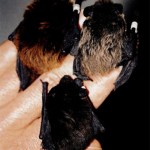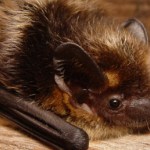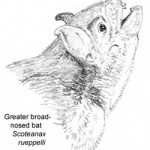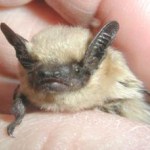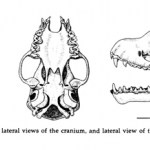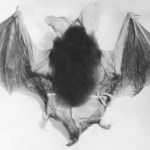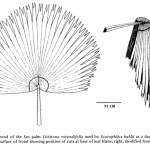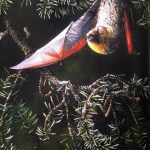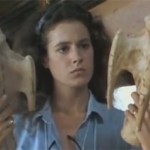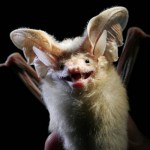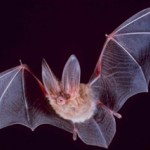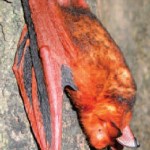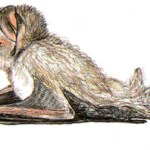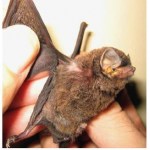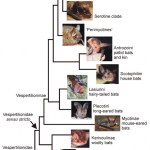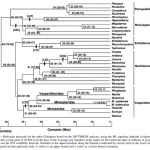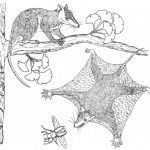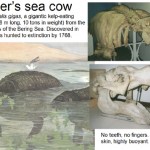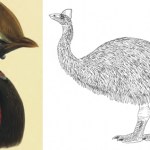
As we've seen throughout this series (see links below for previous parts), recent phylogenetic studies have found a number of 'pipistrelle-like non-pipistrelles' to form a novel clade previously unsuspected from morphological studies [composite above shows - l to r - Hypsugo cf. joffrei (from Kruskop & Shchinov (2010)), Neoromicia capensis (from Fernloof Nature Reserve), and Laephotis botswanae]. Following Roehrs et al. (2010), I'll refer to this as the 'hypsugine group'. Hypsugines occur across the Old World and Australasia, and at the 'core' of the group are the Hypsugo species.…
A group of mostly mid-sized pipistrelle-like bats of Africa and the northern continents are known as the serotines (Eptesicus) [species shown here is the one generally known simply as the Serotine E. serotinus: photo by Mnolf, from wikipedia]. Here in Europe this is - along with pipistrelles, noctules and long-eared bats - one of the most familiar of vesper bat groups. As we'll see, this group is anything but boring: it includes some weird big-eared species as well as the only bats known to breed within the Arctic Circle and a 'giant' species that eats birds.
Substantial confusion has…
A group of serotine-like bats that occur in North America, Cuba, tropical Africa, Asia and Australasia have often been grouped together in a 'tribe' called Nycticeini (or Nycticeiini: both spellings are used in the bat literature and I'm unsure which has proper precedence). Tate (1942) used this name for an assemblage of species grouped together due to the absence of the second upper incisor. Nycticeins also tend to have a near-horizontal dorsal border to the naked muzzle and a slow, steady flight. The name is obviously based around the generic name used for the so-called evening bats (…
Once upon a time, a huge variety of small to very small vesper bats - basically all of those that possess a simple tragus, a shortish face, two pairs of upper incisors and two upper and two lower premolars - were lumped together as the pipistrelles. You don't have to have a detailed or expert knowledge of vesper bat diversity or morphology to realise that at least some of these characters are primitive across Vespertilionidae, or have evolved repeatedly in disparate lineages. When these observations are combined with the morphological and molecular differences present among the many species…
Vesper bats. Well done with sticking with it all so far - I have lots of non-bat stuff I want to cover, but (for reasons soon to be explained) I need to get this series finished. With this article - part XI in the series (XI) - we are not at the end. But we are at the beginning of the end. Look at the cladogram below to see where we are, and follow the links below if you want to know what happened before. We arrive now at Antrozoini...
The Pallid bat or Desert bat Antrozous pallidus of western North America and Cuba is a large (wingspan 37-41 cm; mass 20-35 g), fairly scary-looking, big-…
About 12 species of big-eared Australasian bats are known as the, err, Australian big-eared bats and New Guinean bats. More formally, they are the Nyctophilus species. They're also known from some of the islands that surround New Guinea (like the Lesser Sundas), and also from New Caledonia (an endemic New Caledonian species, N. nebulosus, was named in 2002). Their presence has also been claimed for Fiji, but the evidence for this (based on specimens stored at the Natural History Museum in London) is inconclusive (J. E. Hill, in Parnaby 2002). Together with the New Guinea big-eared bat or…
Hey, if anyone out there is bored with the bats, just gimme a shout. If you're loving it, say so, and urge me to post more - there's still a lot to come! Yes, welcome once again to the vesper bat series: for previous installments see the list of links at the bottom of this article. We continue our trek through vesper bat diversity with another of the clades often regarded as a 'tribe' within the vesper bat 'subfamily' Vespertilioninae: the house bats or yellow bats, conventionally grouped together in Scotophilini.
House bats - the approximately 15 species of Scotophilus - are handsome,…
Now that all the fuss about modern-day sauropod dinosaurs has died down, we can get back to the serious business of vesper bats (incidentally, I do plan to cover the mokele-mbembe - in serious fashion - at some point in history). For previous parts in the vesper bats series, please look at the links below.
A group of about 17 species of American bats (occurring from Alberta down to Chile and Argentina) are known collectively as the hairy-tailed bats or hoary bats (Lasiurus*) (together with the Silver-haired bat Lasionycterus noctivagans, they're also sometimes known as tree bats).
Most…
PLEASE NOTE (ADDED 2012): IT SHOULD BE EXTREMELY OBVIOUS THAT THIS ARTICLE IS AN APRIL FOOL'S JOKE, NOT A DESCRIPTION OF REAL RESEARCH.
Today sees the publication of what is surely the century's most significant zoological discovery. After decades of searching, Africa's mystery Congolese swamp monster, the Mokele-Mbembe, has been discovered - it is a living sauropod dinosaur, and it radically alters our understanding of archosaur phylogeny, sauropod biology and diversity, and indeed the evolutionary process as a whole.
As is fitting for the discovery of a brand new, extant, hitherto…
In the previous article we looked at the majority of taxa included within the 'plecotin' group. As discussed therein, while there may be a clade of 'core plecotins', the traditional concept of the group might be paraphyletic. Some plecotins - Idionycteris in particular - might even be outside the clade that includes plecotins and all other vespertilionines. Here we look at a particularly interesting group of vesper bat species that might, or might not, be part of the 'core plecotin' clade: the desert long-eared bats (Otonycteris). What makes desert long-eared bats especially interesting is…
Yay, more vesper bats! The groups we've looked at so far have - in anatomical terms - been pretty conservative. This time round we're looking at a really remarkable group; as is so often the case, their familiarity (relative to so many others of the world's bats) means that we tend to forget or ignore how remarkable they are. Ordinarily, you might balk at the idea of a mammal whose ears are longer than the combined length of its head and body. Yet this is exactly what we have in the long-eared bats (or, in the Plecotus species at least). Yes, welcome to the world of... yeah, long-eared bats…
One of the largest and most successful vesper bat clades is Myotis, the little brown bats or mouse-eared bats. As you can see from the simplified cladogram shown right down at the bottom of this article, recent work indicates that they form the sister-taxon to the remaining vespertilionine vesper bats (for more discussion of their phylogenetic position, see the vesper bat cladogram article). Myotis occurs virtually worldwide in diverse habitats, contains about 100 species, and has been described as the most widespread mammalian genus after Homo* [composite below shows - clockwise from far…
Time to continue our trek across the vesper bat cladogram. In the previous article we looked at the bent-winged bats (or miniopterids, or miniopterines): a highly distinctive, morphologically novel group that seem to have diverged from vesper bats proper something like 45 million years ago. Their distinctive nature and long history of isolation relative to other lineages conventionally included within Vespertilionidae mean that bent-winged bats are now argued by many to be worthy of 'family' status. As we'll see here, they're no longer unique - bat workers now argue that another lineage of…
Welcome to part III of the vesper bat series though, as we'll see, the bats I'm covering here are not really vesper bat at all (anymore, and in the strictest sense of the term 'vesper bat'). They are the extremely strange, highly widespread long-winged bats, long-fingered bats or bent-winged bats (Miniopterus). Of these vernacular names, I prefer 'bent-winged bats'. As you can see from the simplified cladogram shown below, they're consistently found as the sister-group to virtually all other lineages conventionally included within Vespertilionidae [adjacent photo, from wikipedia, shows…
So, in the previous article we introduced vesper bats (sensu lato) as a whole, covered the idea that they're pretty diverse in morphology and behaviour, and also looked quickly at where they seem to fit within the bat family tree as a whole. As you'd predict for a diverse group of over 400 species, there have been numerous attempts to group these many species into clades, and to work out the patterns of evolution within the group. A large number of 'subfamilies' and 'tribes' have been named for different assemblages of vesper bat species, though a comparatively small number of useful…
Bats are one of those groups of animals that I've come back to on several separate occasions, yet have never dealt with in satisfactory fashion (that is, comprehensively). Seeing as the group includes over 1110 living species, I hope that this is forgivable. But I have plans, and over the last few weeks a number of coincidental and unrelated events have caused me to do a lot of thinking and writing about the enormous, hugely successful, globally distributed microbat group known as Vespertilionidae.
The bats in this group are variously known collectively as common bats, plain-faced bats,…
Well, the whole 'distributed denial of service' thing has done a pretty effective job of keeping me away from Tet Zoo entirely. No chance to blog, and not even the chance to look at the site at all - so, wow, thanks for keeping the protobats discussion going (97 98 comments... not bad). While those jolly nice people at ScienceBlogs tech support have just unblocked my IP address, it seems that lots of readers remain blocked - I see Tet Zoo sliding down the ratings a bit over on Nature Blog Network. Yikes, fifth place! Anyway, I'm just about ready to start deluging Tet Zoo with the enormous…
Reconstructions of the earliest phases of bird evolution - of 'near-birds' or 'protobirds', if you will - are pretty familiar, and hypothetical 'proto-pterosaurs' are also relatively familiar thanks to their appearance in the mainstream literature (Wellnhofer 1991, Unwin 2006). However, have you ever seen a reconstruction of a proto-bat? Such creatures must have existed, of course, but I'm only aware of one published effort to visualise them. Reproduced here, these reconstructions were originally published in Smith (1977) and were later reproduced in John Hill and James Smith's excellent…
I don't have time for anything at the moment, it's terrible. So here's this, from one of my talks on marine mammal diversity and evolution...
For more on Pezosiren portelli, see Domning (2001); the diagram contrasting the prorastomid, protosirenid and crown-sirenian is from Domning (2000). The Steller's sea cow painting is by Maurice Wilson. Sirenians were previous covered on Tet Zoo in When manatees crossed the Atlantic.
Refs - -
Domning, D. P. 2000. The readaptation of Eocene sirenians to life in water. Historical Biology 14, 115-119.
- . 2001. The earliest known fully quadrupedal…
I have a great liking for cassowaries, and I've had good reason to write about them several times. I've also had fun playing with preserved specimens and skeletons - something I must elaborate on at some time. Back in 2006 - the days of Tet Zoo ver 1 - I blogged some of my cassowary-related musings, and in the interests of both recycling and of getting credit for stuff I've already gotten credit for before, I repost them here. Partly due to laziness, I never did include the article you're about to read - some say one of my all-time greatest articles ever - in the book Tetrapod Zoology Book…
